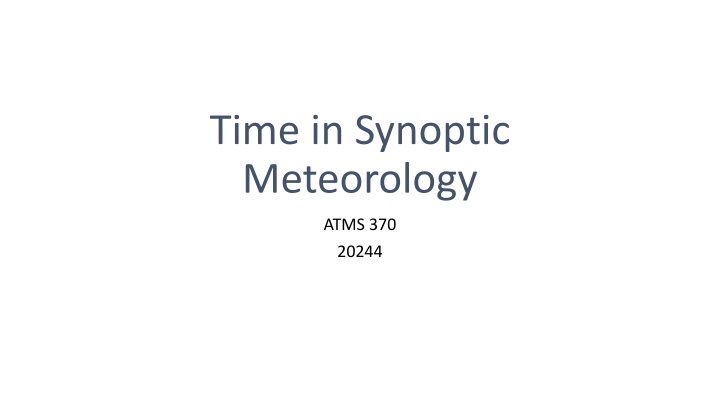
Time Conversion in Synoptic Meteorology
Meteorologists worldwide rely on a standardized time system based on the Greenwich Meridian. This system, which includes GMT, UTC, and Zulu Time, allows for consistent data exchange across the globe. By converting between local time and UTC, meteorologists can accurately interpret weather maps and forecasts. Learn how to perform these conversions seamlessly to enhance your understanding of synoptic meteorology.
Download Presentation

Please find below an Image/Link to download the presentation.
The content on the website is provided AS IS for your information and personal use only. It may not be sold, licensed, or shared on other websites without obtaining consent from the author. If you encounter any issues during the download, it is possible that the publisher has removed the file from their server.
You are allowed to download the files provided on this website for personal or commercial use, subject to the condition that they are used lawfully. All files are the property of their respective owners.
The content on the website is provided AS IS for your information and personal use only. It may not be sold, licensed, or shared on other websites without obtaining consent from the author.
E N D
Presentation Transcript
Time in Synoptic Meteorology ATMS 370 20244
Meteorologists need to use the Meteorologists need to use the same time everywhere since we same time everywhere since we exchange data globally exchange data globally
Meteorologists use the local standard time at the Greenwich Meridian (0 longitude, near London).
Meteorologists use the local standard time at the Greenwich Meridian (0 longitude, near London). Many names for this time: Greenwich Mean Time (GMT) Universal Coordinated Time (UTC) Zulu Time (Z) Generally, UTC is used today, but some groups (like the NWS) often use Z and GMT.
How to convert. UTC is LATER than Pacific time since the Greenwich Meridian is to our east UTC = PST + 8 hr UTC = PDT + 7 hr Uses a 24 hr clock First, convert local time to 24 hr clock Then, add 7 or 8 hr depending on whether in daylight or standard time. If the sum is equal to or greater than 24 hr, subtract 24h and add one day.
Examples 4 AM PDT 1 October: 4 AM become O4 Add 7 hr = 11 UTC 1 October 4 PM PDT 1 October 4 PM become 16 Add 7 hr = 23 UTC 1 October 6 PM PST 1 January 6 PM becomes 18 18 + 8= 26 UTC. Need to subtract 24 and becomes 02 UTC 2 January Your test: 10 PM PST 1 January is what in UTC? You need to be able to do this conversion or you won t be able to understand weather maps.
